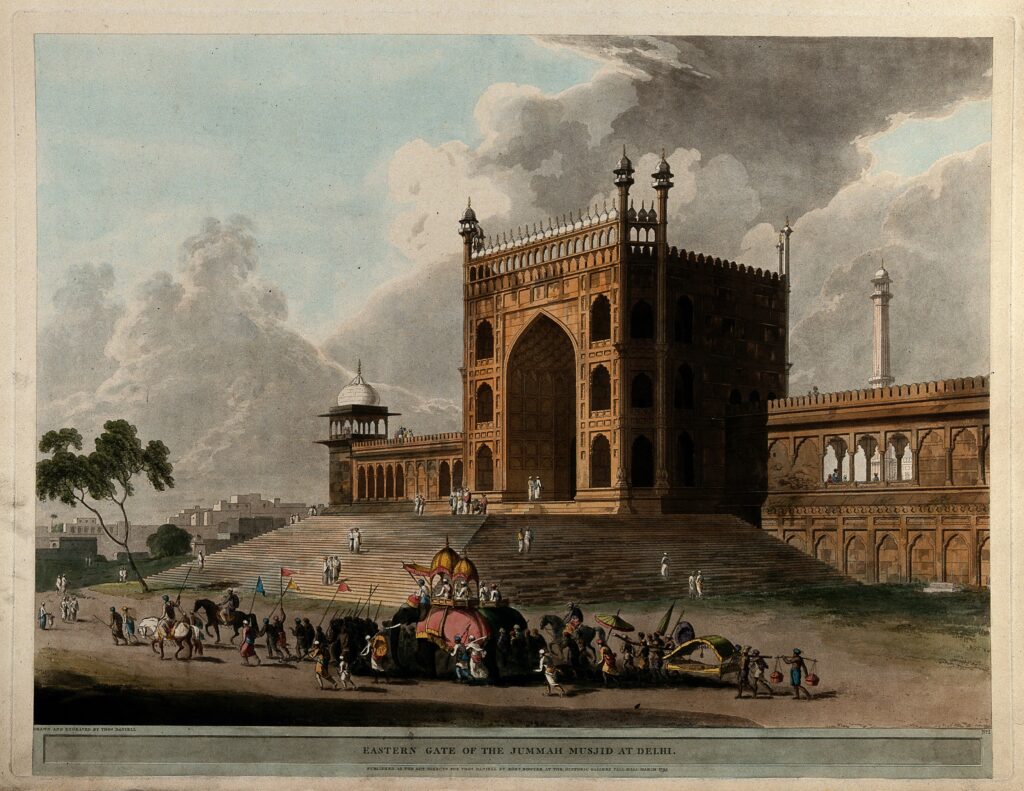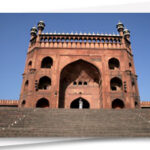This great mosque of Old Delhi is the largest in India, with a courtyard capable of holding 25,000 devotees. It was begun in 1644 and ended up being the final architectural extravagance of Shah Jahan, the Mughal emperor who built the Taj Mahal and the Red Fort.The highly decorative mosque has three great gates, four towers and two 40 m-high minarets constructed of strips of red sandstone and
Construction and Mughal
Mughal Emperor Shah Jhan built the Jama Masjid between 1650 and 1656, at the highest point of Shahjahanabad. The mosque was designed by architect Ustad Khalil, and constructed by approximately 5000 workers.The workforce was diverse, consisting of Indians, Arabs, Persians, Turks, and Europeans.

The construction was supervised primarily by Sadullha Khan, the Wazir (or prime minister) during Shah Jahan’s reign, and Fazil Khan, the comtroller of Shah Jahan’s household. The cost of the construction at the time was ten lakh (one million) rupees. The mosque was inaugurated on 23 July, 1656 by Syed Abdul Ghafoor Shah Bukhari, from Bukhara, Uzbekistan. He had been invited by Shah Jahan to be the Shahi Imam (Royal Imam) of the mosque.
The mosque was one of the last monuments built under Shah Jahan. After its completion, it served as the royal mosque of the emperors until the end of the Mughal period. The khutba was recited by the Mughal emperor during the Friday noon prayer, legitimising his rule. The mosque was hence a symbol of Mughal sovereignty in India, carrying political significance. It was also an important centre of social life for the residents of Shahjahanabad, providing a space transcending class divide for diverse people to interact.
British Raj
The British took over Shahjahanabad in 1803. The Mughal Emperor remained the ritual imperial head of the mosque, but Mughal power and patronage had significantly waned.

The initial policy of the British in the city was favourable towards its residents; the British undertook repairs and even renovations of the Jama Masjid. The Masjid continued to serve as a site of social and political discourse, in keeping with other mosques of Delhi at the time; for example, theological and philosophical debates were held between Muslims and Christians.
The Revolt of 1857 was a major turning point in this situation. This event resulted in the deaths of many British people in the city, and weakened colonial authority, deeply affronting the British. It also ended the Mughal empire. The British perceived the revolt as instigated by Muslims, cultivated within Delhi’s mosques. After the British reclaimed the city in the same year, they razed many mosques and banned the congregation of Muslims in any remaining mosques. The Jama Masjid fell into British confiscation during this time, and was barred from any religious use. It was repeatedly considered for destruction, but the British eventually began using it as barracks for its Sikh and European soldiers. This was a desecration of the space; Aziz characterises the decision as deliberate, in order to insult the sentiments of the city’s Muslim inhabitants.
The Masjid was eventually returned to the Muslim population in 1862, due to their increasing resentment of British actions. Multiple conditions were imposed, including the usage of Jama Masjid as strictly a religious site, as well as mandatory policing by the British. The Jama Masjid Managing Committee (JMMC), consisting of respected Muslims of Delhi, was established as a formal body to represent the mosque and enforce these conditions.
Upon its return, the Jama Masjid was reestablished as a mosque. Though the Mughal state had been dissolved, the mosque received patronage from various regional Islamic rulers and nobles. In 1886, the Nawab of Rampur donated a large sum of 1,55,000 rupees to facilitate repairs. In 1926, a donation from the Nizam of Hyderabad of 1,00,000 rupees was used for similar purposes.
Growing unrest against British rule manifested in Delhi’s mosques from 1911. The Jama Masjid was frequently used for non-religious, political purposes, against the rules instituted. While the British could police and clamp down on political activities in public spaces, the Jama Masjid was a religious space and was hence protected from such action, by both law (Religious Endowment Act, 1863) and the sentiments of Delhi.
Post-Colonial
The Jama Masjid continued to be a political symbol after independence.
Indian independence activist Abdul Kalam Azad delivered a speech from its pulpit during the Friday prayer of 23 October, 1947. The Partition of India was underway, causing massive population movements in Delhi. Azad implored the Muslims of Delhi to remain in India, and attempted to reassure them that India was still their homeland.
Modern
The Jama Masjid serves as Delhi’s primary mosque, and has a largely congregational function.

The Muslims of the city traditionally gather here to offer communal Friday prayer, as well as for major festivals such as EID The mosque is also a major tourist attraction, and derives a significant amount of income through the visits of foreigners.
The function of the mosque as an autonomous political space has continued in the modern era. For example, in 2001 (in the aftermath of the 9/11 Attacks) the mosque was a site of protest against U.S bombings in Afghanistan. In 2019, massive protests occurred at the site due to the controversial.
2006 Jama Masjid explosions
On the 14th of April in 2006, there were Two explosision which came soon after Friday prayers and occurred in swift succession.
.jpg)
It was unclear how the blasts occurred. Among the casualties, one was in serious condition, whereas eight other people sustained minor injuries. Imam Ahmed Bukhari commented, “there is anger among our people but I am appealing to them to maintain calm.
2010 Jama Masjid attack
Note: 2010 Jama Masjid Attack
On the 15th of September in 2010, two Taiwanese tourists were injured after gunmen on a motorcycle opened fire on a bus parked near gate number three of the mosque. After the attack, the police detained 30 people to question and the area was turned into a fortress because policemen were heavily deployed.
In November 2011, the Delhi Police arrested six members of the Indian Mujahideen who were believed to be behind the Jama Masjid blast along with the Puney Jerman Bakery blast. Sources said that the “‘main man’ Imran” allegedly planted the bomb in a car outside the mosque. In September 2013 it was reported that Yasin Bhatkall, a leader of the group, along with Assadullah Akhtar, were arrested the month before and they admitted that they carried out the attack with the on-the-run Pakistani national Waqas. Yasin said that he was ordered by Karachi-based IM head Riyaz Bhatkal to do the task as the Imam allowed “semi-naked” foreigners inside it.
Architecture
The Jama Masjid was built as a part of Shah Jahan’s new capital in Delhi, Shahanjabad. At the time of its construction, it was the largest mosque in the Indian subcontinent. Shah Jahan claimed that the mosque was modelled after the Jama Masjid of Fatehpur Sikri, and this is reflected in the design of many exterior features, such as the facade and courtyard. However, the interior of the mosque more closely resembles the Jama Masjid of Agra The mosque predominantly uses red sandstone, and is set apart from its predecessors by a more extensive usage of white marble. Black marble also features as a decorative element. Arabic and Persian calligraphic pieces are found on various surfaces of the structure, whose content ranges from religious to panegyric.
Having been built on a hill, the mosque is situated on a plinth elevated 10 metres above the surrounding city. The complex is oriented to the west, towards Mecca An imperial college, imperial dispensary, and Madarsa used to lie adjacent to the structure


Be the first to reply